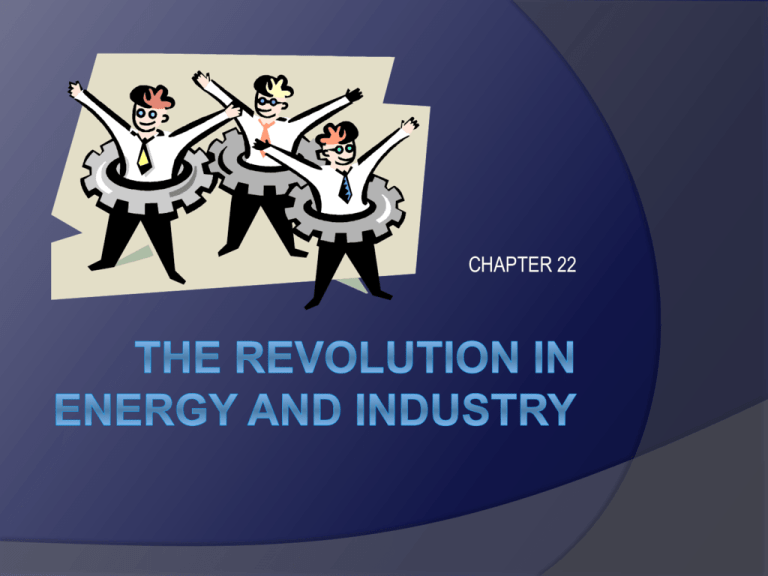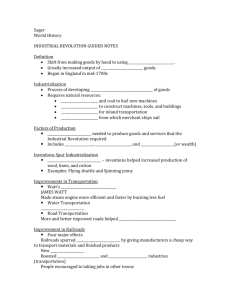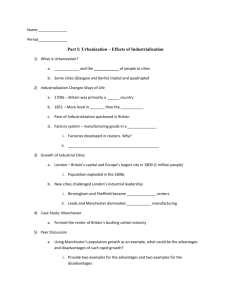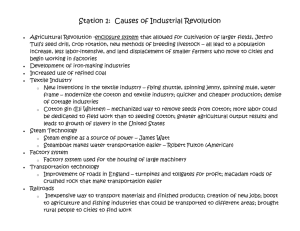The Revolution in Energy and Industry
advertisement

CHAPTER 22 Learning Targets After reading and studying this chapter, students should be able to discuss the factors that led to the revolution in energy and industry. Understand the key role of James Watt’s steam engine in breaking the power “ceiling” in England and continental Europe. Explain the effects of the Industrial Revolution on people’s lives ○ in particular the effects on the diet, ○ living standards, and ○ work environment of workers in Britain. Discuss how the Industrial Revolution reinforced the idea of woman’s “separate sphere” ○ the household and child care. Analyze the positive and negative outcomes of the Industrial Revolution. I. The Industrial Revolution in Britain A.Eighteenth-Century Origins 1. Social and economic factors influenced England’s takeoff. a) Colonial markets for manufactured goods contributed. b) The canal network constructed in Britain after 1770 contributed. c) Productive English agriculture meant capital available for investment and spending money for ordinary people to purchase industrial goods. 2. A stable government and an effective central bank also fostered industrial growth in England. England’s textile industry grows beyond demand B. The First Factories 1. A growing demand for textiles led to the creation of the world’s first large factories. 2. The putting-out system could not keep up with the demand. C. The Problem of Energy 1. The cotton textile industry could not have continued to grow using existing energy sources. 2. Britain experienced an energy shortage as the wood supply shrank. The Steam Engine D. The Steam Engine Breakthrough 1. Part of the general revolution was the transformation from wood burning to coal burning. 2. Transportation and manufacturing were revolutionized by steam power. 3. The early steam engines of Savery and Newcomen converted coal into energy. 4. James Watt increased the efficiency of the steam engine. 5. Steam power was used in many industries. Railroads E. The Coming of the Railroads 1. Beginning in the 1830s, railroads transformed the economy, society, and culture. 2. Railroads reduced the cost and uncertainty of overland shipping. 3. The construction of railroads created demand for unskilled labor. The growing working class F. Industry and Population 1. In 1860 Britain produced 20 percent of the world’s industrial goods. 2. Increases in production led to increases in GDP and a population boom. 3. Industrialization and the growth of an urban working class led to the theories of Malthus and Ricardo about the likely consequences of overpopulation and the likely stagnation of workers’ standard of living (“the iron law of wages”). (GDP – Gross Domestic Product) II. Industrialization in Continental Europe Variations in developing countries A. National Variations 1. There were several variations on the industrialization theme. Different countries followed different routes. 2. Belgium and the United States followed Britain’s lead. 3. France showed only gradual growth in the early nineteenth century. 4. By 1913 Germany and the United States were challenging British leadership in industrialization. Problems of industrialization B. The Challenge of Industrialization 1. Continental countries had a number of disadvantages in industrialization. a) The Napoleonic Wars had devastated the European continent. b) It was difficult for continental manufacturers to compete with inexpensive imported British goods. c) As industrial enterprises grew larger, greater and greater investments were required to set them up. d) Continental workers lacked the technological skills British workers had developed. Advantages that help industrialization develop 2. Continental countries also had advantages. a) Most continental countries had a tradition of a successful putting-out system. b) Continental countries could simply borrow advanced British technology. c) Continental countries had strong independent governments. Backing Industrialization C. Agents of Industrialization 1. In Belgium, France, and Prussia the state provided important financial assistance to industrialization. 2. German nationalist Friedrich List promoted economic nationalism, the idea that to industrialize a country needed trade barriers to protect its manufacturers. 3. Changes in banking on the continent, such as the creation of limited liability corporations, also facilitated industrialization. III. Capital and Labor Changing structures A. The New Class of Factory Owners 1. Early industrialists operated in a highly competitive environment. 2. Industrialists came from a variety of backgrounds. 3. Over time, entry into well-developed industries became more difficult. 4. Wives and daughters found it increasingly difficult to participate in the business world. The worker B. The New Factory Workers 1. Factory workers emerged as a new group in society. 2. Many writers portrayed the harsh working conditions for factory workers. 3. Engels lashed out at factory owners in his The Condition of the Working Class in England (1844). 4. Ure and Chadwick argued that industrialization had improved the quality of life for people. 5. Recent statistical studies suggest that workers’ standard of living began to rise after 1820. Life of the laborer C. Conditions of Work 1. Factory work meant more discipline and loss of personal freedom. 2. Child labor increased. 3. Children and parents worked long hours. 4. Parliament sought to limit child labor (the Factory Act of 1833). Gender D. The Sexual Division of Labor 1. Family employment carried over into early factories. 2. A variety of factors contributed to the reorganization of work along gender lines. 3. Eventually the Industrial Revolution strengthened the notion of a woman’s “separate sphere,” as women increasingly stayed home to take care of the household while men went to the factories. Unions E. The Early Labor Movement in Britain 1. Working-class solidarity developed in small workshops and large factories. 2. Poor working conditions, starvation wages, and the liberal capitalist legal attack on artisan guilds led to the development of workers’ organizations (trade unions). 3. The next stage in the British trade union movement was the effort to create a single national union. 4. British workers also engaged in direct political activity in defense of their own interests. Learning Targets After reading and studying this chapter, students should be able to discuss the factors that led to the revolution in energy and industry. Understand the key role of James Watt’s steam engine in breaking the power “ceiling” in England and continental Europe. Explain the effects of the Industrial Revolution on people’s lives ○ in particular the effects on the diet, ○ living standards, and ○ work environment of workers in Britain. Discuss how the Industrial Revolution reinforced the idea of woman’s “separate sphere” ○ the household and child care. Analyze the positive and negative outcomes of the Industrial Revolution.






